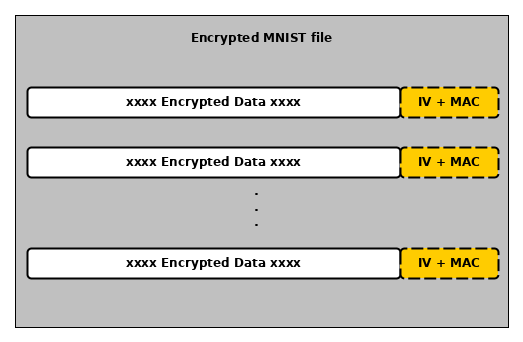Pliniusis a secure machine learning framework which leveragesIntel SGXfor secure training of neural network models, andpersistent memory(PM) for fault tolerance.- Plinius consists of two main libraries: sgx-romulus which is an Intel SGX-compatible PM library we ported from Romulus PM library, and sgx-dnet which is a port of Darknet ML framework into Intel SGX.
- This readme gives a quick rundown on how to test secure training in Plinius as described in our paper.
- NB: Commands here are for linux-based systems
- Prerequisites: to build and run this project you must have atleast (simulation mode only) the Intel SGX SDK installed.
- As described in the paper, training a model in Plinius is summarized in the workflow below:

- For the sake of simplicity we assume RA and SC have been done successfully and the encryption key has been provisioned to the enclave.i.e
enc_keyvariable in trainer.cpp. This is the same key used for encrypting the mnist data set. - We created an encrypted version of the MNIST data set, located in the
App/dnet-out/data/mnistfolder. - The encrypted images are divided into four chunks:
img.a-e. - Combine the images into one file with the command:
cat img.?? > enc_mnist_imgs.data enc_mnist_imgs.datacontains 60k encrypted mnist images andenc_mnist_labels.datacontains 60k corresponding encrypted labels.- The images and labels are encrypted with AES-GCM encryption algorithm, with a 16 byte MAC and 12 byte IV attached to each encrypted element (e.g. image or label).
t10k-images*andt10k-labels*represent the images and labels in the default MNIST test dataset.- For clearer comprehension, the encrypted image and label files have the form below:

- If you have a machine with real persistent memory, use the following commands to format and mount the drive with DAX enabled. We assume the PM device is
/dev/pmem0.
$ sudo mkdir /mnt/pmem0
$ sudo mkfs.ext4 /dev/pmem0
$ sudo mount -t ext4 -o dax /dev/pmem0 /mnt/pmem0
- If you do not have real PM, you can emulate it with DRAM (ramdisk), using a temporary filesystem (i.e
tmpfs) using the following instructions.
$ sudo mkdir /mnt/pmem0
$ sudo mount -t tmpfs /dev/pmem0 /mnt/pmem0
- All plinius data will then be stored in
/mnt/pmem0/plinius_data. Modify this path if needed in the file: Romulus_helper.h. - By default, Plinius uses a
CLFLUSHinstruction for persistent write backs. You can modify this to use an optimized cache-line flush instruction likeCLFLUSHOPTsupported by your CPU. To do this, redefine thePWBmacro in pfences.h accordingly. For example:#define PWB_IS_CLFLUSHOPT.
- Plinius is mainly designed for model training but we can do inference too. We added the default mnist test set (10k unencrypted labeled images) just for the purpose of testing the accuracy of our trained model.
- In a real setting a programmer who wishes to do inference with Plinius will have to encrypt his inference set and load to PM following the same idea/workflow.
- We used mnist data set as a proof of concept, the same idea can be applied with a different data set once the workflow is understood.
- As described in the paper, we first initialize sgx-rom in the main routine via
rom_initandecall_initand invoke thetrain_mnistfunction. train_mnistreads the corresponding network/model configuration file and parses it into a config data structure and sends this to the enclave runtime via theecall_trainerecall. The config file used in this example describes a neural network model with 12 LRELU convolutional layers + other intermediary pooling layers, batch size of 128, learning rate of 0.1 and other important hyperparameters. Feel free to modify the config as it suits you, but make sure to follow the correct syntax (i.e Darknet config file syntax).- In the enclave we load the encrypted data once into PM and begin the training iterations.
- For each iteration, the routine reads batches of encrypted data from PM, decrypts the former in the enclave, trains the model with the batch, and the mirrors-out weights to PM.
-
Clone this project to your local environment. Modify the
SGX_MODEin theMakefilei.eHWmode if you have real SGX hardware andSIMotherwise. -
If working in SGX simulation mode, load SGX simulation env variables with:
source /opt/intel/sgxsdk/environment, assuming you installed the SGX SDK in/opt/intelwhich is the default folder for that installation. Otherwise, replace that part accordingly. -
Build the project using
makecommand. -
Run the program via
./plinius -
The encrypted data will be read once into PM and training will begin. You can see the loss/average loss decreasing as training proceeds.
-
To test the fault tolerance capabilities, interrupt the program with a
ctrl+cand restart it again. Upon restart, training data is already in PM and training resumes from the iteration it left off. -
After training, the program will invoke
test_mnistto test the accuracy of the trained model. -
The above model config yields 98.5% accuracy on the 10k test set for 1 training epoch(500 iterations). We can achieve higher accuracy by modifying the network structure and learning hyperparameters.
-
Have fun !!!